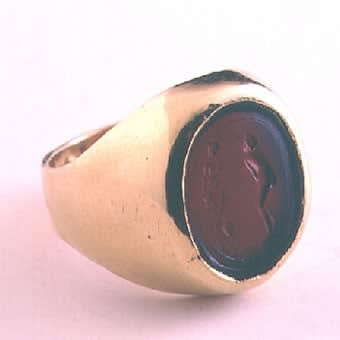Tassie Glass Intaglio Depicting a Naked Woman, 18th Century CE
Glass,Gold
FJ.6471
The late eighteenth century in Europe witnessed a revival of interest in the art, architecture and literature of antiquity. It became customary for the sons of wealthy families to embark...
The late eighteenth century in Europe witnessed a revival of interest in the art, architecture and literature of antiquity. It became customary for the sons of wealthy families to embark upon a ‘Grand Tour’ as part of their education and Italy was the principle destination. The ruins of Rome and the rediscovery of sites such as Pompeii and Herculaneum helped to stimulate the market for antiquities. The purchase of souvenirs abroad, whether genuine or of recent manufacture, helped to spread this fashion for the antique.
James Tassie (1735-1799) was one of a number of highly skilled artists who capitalised on this demand. Born in Scotland he started his career as a stonemason before returning to study sculpture and modelling at the Glasgow Academy. Having travelled to Dublin in Ireland to seek commissions, he made the acquaintance of an amateur gem engraver, Dr Quinn. Together the two men developed a new type of white enamel that was ideally suited to portrait medallions. However it was after relocating to London in 1766 that Tassie’s career as a gem engraver really took off. He soon acquired an international reputation, and received a commission for 15,000 pieces from Catherine the Great, Empress of Russia. Many prestigious European collections were made accessible to him for the purposes of study. His knowledge of antique designs was highly esteemed and he was commissioned to provide designs for Josiah Wedgwood. In fact his gems and medallions proved so popular that the business continued to flourish in the early nineteenth century under the direction of his nephew William Tassie.
Tassie was a master at depicting extraordinary anatomical detail on a miniature scale; and this lovely intaglio is a perfect example. The beautifully engraved young woman displays great expression, movement and character. Her right leg is bent at the knee, her body twisted slightly, her face looking upwards. She wears a soft hat or scarf, her pretty profile very clearly delineated. She stares intently at an object, or collection of objects, appearing to arise from the ground. It is perhaps a tree hung with various items, including an amphora as a possible votive offering. Some traditions describe Venus as the goddess of gardens, her principle plants being rose and myrtle. The graceful form and elegance of this woman bears a strong resemblance to ancient statues of the goddess of love. Tassie has here created a scene of innocence and sensuality, mystery and elegance which will always be a source of delight.
James Tassie (1735-1799) was one of a number of highly skilled artists who capitalised on this demand. Born in Scotland he started his career as a stonemason before returning to study sculpture and modelling at the Glasgow Academy. Having travelled to Dublin in Ireland to seek commissions, he made the acquaintance of an amateur gem engraver, Dr Quinn. Together the two men developed a new type of white enamel that was ideally suited to portrait medallions. However it was after relocating to London in 1766 that Tassie’s career as a gem engraver really took off. He soon acquired an international reputation, and received a commission for 15,000 pieces from Catherine the Great, Empress of Russia. Many prestigious European collections were made accessible to him for the purposes of study. His knowledge of antique designs was highly esteemed and he was commissioned to provide designs for Josiah Wedgwood. In fact his gems and medallions proved so popular that the business continued to flourish in the early nineteenth century under the direction of his nephew William Tassie.
Tassie was a master at depicting extraordinary anatomical detail on a miniature scale; and this lovely intaglio is a perfect example. The beautifully engraved young woman displays great expression, movement and character. Her right leg is bent at the knee, her body twisted slightly, her face looking upwards. She wears a soft hat or scarf, her pretty profile very clearly delineated. She stares intently at an object, or collection of objects, appearing to arise from the ground. It is perhaps a tree hung with various items, including an amphora as a possible votive offering. Some traditions describe Venus as the goddess of gardens, her principle plants being rose and myrtle. The graceful form and elegance of this woman bears a strong resemblance to ancient statues of the goddess of love. Tassie has here created a scene of innocence and sensuality, mystery and elegance which will always be a source of delight.
